All about video capsule endoscopy
Written in association with:Leading consultant gastroenterologist and specialist endoscopist Dr Adam Humphries discusses what a video capsule endoscopy is, in expert detail.

What is video capsule endoscopy?
Video capsule endoscopy is a modern, non-invasive diagnostic tool used to examine the small intestine, which is often difficult to view with traditional endoscopic methods. The procedure involves swallowing a small capsule equipped with a tiny camera, light, and a transmitter. As the capsule moves through the digestive tract, it captures images of the intestinal walls, transmitting them to a recorder worn by the patient. This allows doctors to get a detailed view of the small intestine and detect any abnormalities.
How does video capsule endoscopy work?
The video capsule endoscopy procedure is simple and generally well-tolerated by patients. Here’s a step-by-step outline of how it works:
- The patient swallows a capsule the size of a large vitamin pill.
- The capsule contains a tiny camera, a light source, a battery, and a wireless transmitter.
- As the capsule passes through the digestive system, it takes thousands of pictures.
- These images are transmitted to a recording device, which the patient wears around their waist.
- After about 8 hours, the capsule passes naturally through the digestive system and is excreted.
- The images are then downloaded, and a gastroenterologist reviews them to detect any issues.
What conditions can video capsule endoscopy diagnose?
Video capsule endoscopy is particularly helpful for diagnosing conditions affecting the small intestine, an area not easily accessible by standard endoscopy or colonoscopy. Some conditions it can help identify include:
- Crohn’s disease
- Unexplained gastrointestinal bleeding
- Small intestine tumours or polyps
- Coeliac disease
- Obscure abdominal pain
It is often recommended when other tests, such as colonoscopy or traditional endoscopy, have been inconclusive.
What are the benefits of video capsule endoscopy?
One of the main advantages of video capsule endoscopy is its ability to explore the entire small intestine, which is not easily reachable through conventional methods. Other benefits include:
- Non-invasive: No need for sedation, incisions, or scopes.
- Convenient: Patients can continue with most of their daily activities during the procedure.
- Painless: There is no discomfort associated with the capsule moving through the digestive system.
- Detailed images: It provides high-resolution pictures of the small intestine, aiding in accurate diagnosis.
What should patients expect during and after the procedure?
Patients are typically required to fast for 12 hours before the procedure to ensure the capsule can capture clear images. In some cases, a bowel-cleansing solution may be given to further improve visibility. During the test, patients swallow the capsule and can go about their normal activities, though they may be advised to avoid strenuous physical activity. The capsule is naturally excreted through the bowel, usually within 24 hours, without causing any pain or discomfort.
Are there any risks or limitations to video capsule endoscopy?
While video capsule endoscopy is generally safe, it is not without potential risks or limitations. Some considerations include:
- Capsule retention: In rare cases, the capsule can get stuck in the digestive tract, particularly if there are strictures or blockages. This may require additional procedures to retrieve the capsule.
- Limited control: Unlike a standard endoscopy, doctors cannot manoeuvre the capsule or take biopsies. This means if an abnormality is found, further tests may be needed.
- Not suitable for everyone: Patients with certain medical conditions, such as swallowing disorders or pacemakers, may not be candidates for the procedure.
What are the advantages and challenges of using video capsule endoscopy?
Video capsule endoscopy offers many advantages, but it’s also important to be aware of some challenges.
Advantages:
- Detailed view of the small intestine.
- Ability to detect hard-to-find conditions.
- Non-invasive and generally well-tolerated.
Challenges:
- Capsule retention risk in patients with strictures.
- Inability to control or biopsy areas during the procedure.
- Potential need for follow-up testing if abnormalities are detected.
For most patients, video capsule endoscopy is a safe and effective way to diagnose a variety of gastrointestinal conditions, providing a less invasive alternative to traditional methods. If you have questions about the procedure or whether it’s suitable for your condition, Dr Humphries can provide more information based on your individual needs.
If you think you may need a Video capsule endoscopy for a gastroenterology issue, arrange a consultation with Dr Humphries via his Top Doctors profile.


